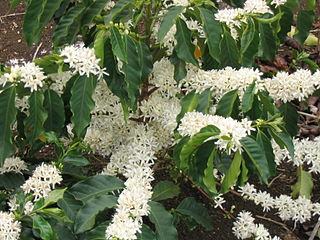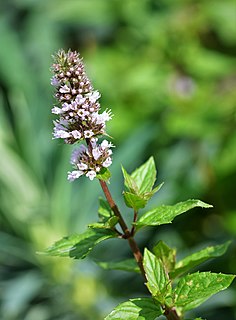
Coffea is a genus of flowering plants in the family Rubiaceae. Coffea species are shrubs or small trees native to tropical and southern Africa and tropical Asia. The seeds of some species, called coffee beans, are used to flavor various beverages and products. The fruits, like the seeds, contain a large amount of caffeine, and have a distinct sweet taste and are often juiced. The plant ranks as one of the world's most valuable and widely traded commodity crops and is an important export product of several countries, including those in Central and South America, the Caribbean and Africa.

The Ericaceae are a family of flowering plants, commonly known as the heath or heather family, found most commonly in acid and infertile growing conditions. The family is large, with c. 4250 known species spread across 124 genera, making it the 14th most species-rich family of flowering plants. The many well known and economically important members of the Ericaceae include the cranberry, blueberry, huckleberry, rhododendron, and various common heaths and heathers.

The Bromeliaceae is a family of monocot flowering plants of 75 genera and around 3590 known species native mainly to the tropical Americas, with a few species found in the American subtropics and one in tropical west Africa, Pitcairnia feliciana.

Trema is a genus of about 15 species of evergreen trees closely related to the hackberries (Celtis), occurring in subtropical and tropical regions of southern Asia, northern Australasia, Africa, South and Central America, and parts of North America. They are generally small trees, reaching 10–20 m (33–66 ft) tall.

Mammea is a flowering plant genus with about 70 species in the family Calophyllaceae. Its members are evergreen trees having edible fruits. The flowers are polygamous, with a unitary calyx opening into two or three valvate sepals. There are 4 to 8 petals. Berries are formed, containing 1 to 4 seeds. The leaves are rigid, coriaceous and often have pellucid dots.
Stachyandra is a plant genus in the family Picrodendraceae first described as a genus in 1990.
Malleastrum depauperatum is a species of plant in the family Meliaceae. It is endemic to Comoros and Aldabra in the Seychelles. It is also known by the synonym Malleastrum leroyi.
Malleastrum is a genus of plants in the family Meliaceae containing 21 species native to Madagascar, Comoros and Aldabra.

Naucleeae is a tribe of flowering plants in the family Rubiaceae and contains about 183 species in 24 genera. Species belonging to Naucleeae occur from Australasia, tropical Asia, Madagascar, tropical Africa, and to the Neotropics and North America.

Gardenieae is a tribe of flowering plants in the family Rubiaceae and contains about 586 species in 53 genera.

Schizolaena is a genus of trees and shrubs in the family Sarcolaenaceae. They are endemic to Madagascar.
Gyrostipula is a genus of flowering plants in the family Rubiaceae. The genus is found on the Comoros and Madagascar.

Nepetoideae is a subfamily of plants in the family Lamiaceae.
Capuronianthus is a genus of flowering plants belonging to the family Meliaceae.
Paracorynanthe is a genus of flowering plants belonging to the family Rubiaceae.
Lepidotrichilia is a genus of flowering plants belonging to the family Meliaceae.
Mantalania is a genus of flowering plants belonging to the family Rubiaceae.
Ranopisoa is a monotypic genus of flowering plants belonging to the family Scrophulariaceae. The only species is Ranopisoa rakotosonii.
Humbertioturraea is a genus of flowering plants belonging to the family Meliaceae.
Neobeguea is a genus of flowering plants belonging to the family Meliaceae.








